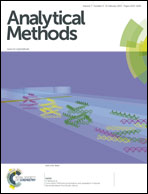A paperfluidic device for dental applications using a novel patterning technique†
Abstract
Dental caries is an irreversible and potentially debilitating disease that can ultimately lead to the loss of the affected tooth structure. Due to a lack of awareness, caries is detected much later after its onset. Moreover, people do not have access to dental care or information in the rural areas of several developing countries. Hence, there is a need for a cheap and disposable point-of-care screening test to determine one's oral health. To cater to this unmet need, we have developed a paperfluidic chip that measures salivary pH to estimate its buffering capacity and also tests susceptibility to caries by checking for salivary reductase. The results of our paper-based reductase assay of 72 samples correlated well with the results obtained using the standard tube-based assay performed in dental clinics. Further, the results of the paper-based pH test matched with those of the caries test, i.e. those with lower saliva pH showed higher susceptibility to caries (since acidic environments promote caries). Here, we also report a new and green technique to chemically pattern paper by printing olive oil through an inkjet printer and turning paper (cellulose) hydrophobic in the oil-treated regions through heat-assisted esterification. In addition to patterning hydrophobic regions on paper, the same inkjet printer was used to print all the assay reagents, thus making our paperfluidic chip completely printable. Since our device is cheap, disposable and can be easily manufactured in large volumes by printing, it is suitable for regular monitoring of oral health as well as providing a basic screening test to those without routine access to dentists.

- This article is part of the themed collection: Microfluidics Research 2015-2016

 Please wait while we load your content...
Please wait while we load your content...